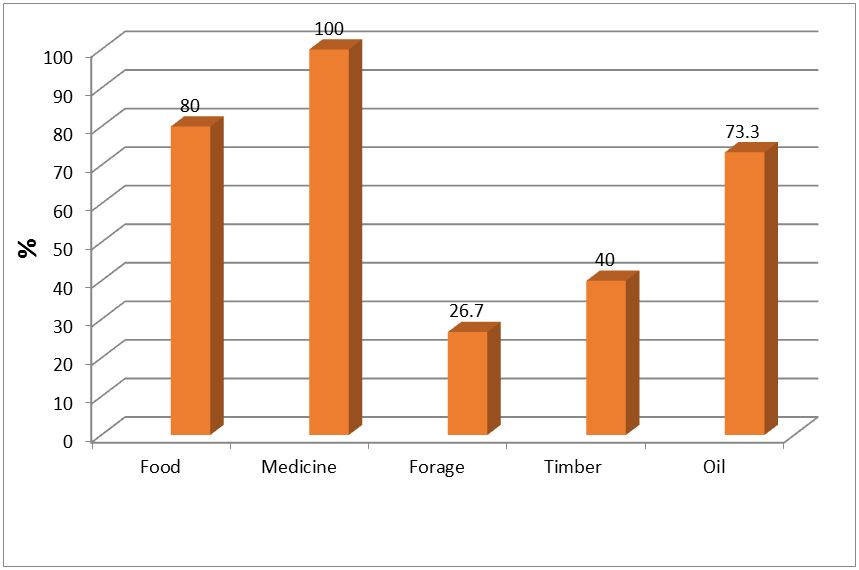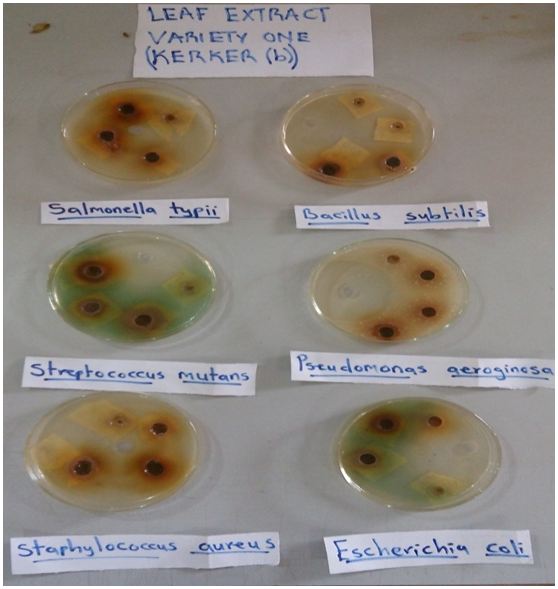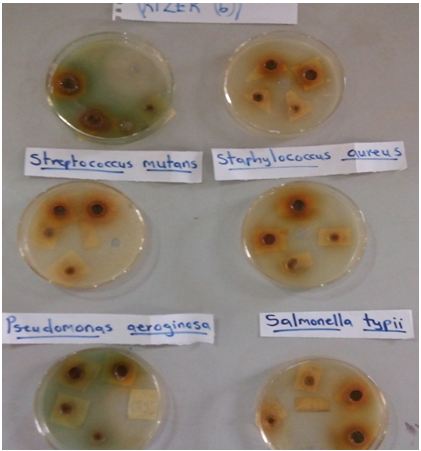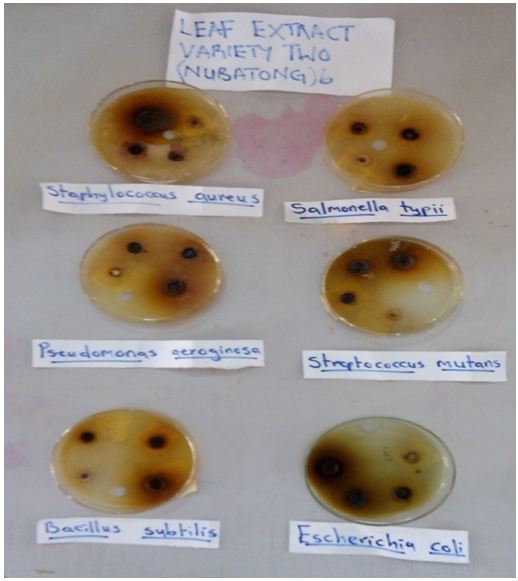A Survey of Some Varieties of Canarium schweinfurthii (Atili) Grown in Some Parts of Jos East LGA, Plateau State, Nigeria and their Antibacterial Activities
A survey was undertaken in Fobur district of Jos-East Local Government Area of Plateau State to document the varieties of Canarium schweinfurthii and their antimicrobial activities. Three (3) villages were selected and five (5) questionnaires were administered in each village. Information on the fruit ripening, flowering periods, accessory attributes, harvesting were ascertained. Also information on weight, length, width, shapes and pre-warming duration were determined. The biochemical determinations and antimicrobial activities of leaves extract on Pseudomonas aeruginosa, Salmonella typhi, Staphylococcusaureus, Streptococcus mutans, Bacillus subtilis and Escherichia coli were investigated. The phytochemical screening was carried out using a standard method while agar well diffusion method was adopted for the antimicrobial activity. The biochemical analysis of leaves extract showed the presence of flavonoids, sterioids, tannins, saponins, terpenoids, carbohydrates and anthraquinones. Alkaloids and cardiac glycosides were absent. Also the phytochemical screening of fruits revealed the presence of carbohydrates, flavonoids and steroids only. The leaf extract from Kerker village inhibited all test organism at all concentrations (400 mg/ml, 200 mg/ml, 100 mg/ml and 50 mg/ml) except for Streptocococcusmutans the average fruit length was 4.3 cm, width, 7.5 cm with an ovate shape taking 8 minutes to prewarm. The leaf extracts from Rizek village inhibited the test organisms except Pseudomonas aeruginosa, the average fruit length was 3.9cm width 6.1cm also an ovate shape, taking 11 minutes to prewarm. While the leaf extracts from Nubatong village only inhibited Streptococcus mutans, Bacillus substilis and Escherichia coli. The fruits average length was 4.3 cm, width 6.3 cm and the pre-warming duration of 12 minutes. The reference drug (ciprofloxacin) gave a significant inhibition zone as compared with test extracts. The study has revealed the different varieties of fruit based on shapes, flowering period, ripening period and other attributes which have been documented. The Minimum Inhibitory Concentration (MIC) on the test organisms was 25 mg/ml and the Minimum Bactericidal Concentration on test organism was 12.5 mg/ml. Based on the findings from this study, Canarium schweinfurthii leaf have revealed active bacterial tendency against microorganisms used.
Keywords: Canarium schweinfurthii; Antimicrobial; Phytochemicals; Leaf Extracts; Jos
In the last few decades, there have been growing concerns and realization among experts that fruits should no longer be considered a luxury but a necessity, since they are essentially good for maintenance of health [1]. Fruits and seeds of plants are a good source of food for humans, including many healthy fats, such as omega fats. According to Gordon (1999), experts recommended the consumption of at least 5.7 g of fruits in our daily diet in addition to cereal, pulse, milk and vegetables.
The survey of a country’s natural resource is an important prerequisite for proper utilization of the raw materials; it also explores the use of plants for shelter, food, medicine, clothing and religious ceremonies [2,3].
Canarium schweinfurthii is one of those plants usually used by indigenous people for its nutritional value; it belongs to the family Burseraceae. A perennial plant found in Africa referred to as black olive, African olive, black elemi etc [4]. In English, it is commonly known as purple canary tree, bush candle amongst others. The tree has geographical distribution throughout Africa, native species found in Angola, Cameroun, Ethiopia, Ghana, Guinea-Bissau, Liberia, Mali, Senegal, Sierra-Leone, Sudan, Tanzania, Togo, Uganda, Zambia and Nigeria [5]. In Nigeria, Nyam, reported that the tree is common in some parts of states like Bauchi, Plateau, Niger, Southern Kaduna and Oyo [6]. In Plateau State, it is found in Pankshin, Bokkos, Jos North, Jos South and Jos East. According to Burkill, the tree grows up to 40m high or more. The fruit is similar in structure and colour to the well-known fruit of the olive [7,8]. The flowers grow in clusters at the end of the twigs, small and green in colour [9]. The fruit has a hard stone seed that is edible and oily [10]. According to Dawang, et al., the tree is a major source of oleoresin that is used in food medicine and has a range of industrial application, [11,12]. Usually presented by local people. The pulp contains 71 % palmatic acid and 18 % oleic acid which is edible Orwa, et al., [5].
The use of plants and plant parts in curing human ailments has been documented in various ancient manuscript such as Bible, Koran, Rigvedas and Material medical of the ancient Greek philosopher Discorides [13]. In Native American, 1,625 species of plants have been used as food, over 2,500 have been found useful for drugs [14,15]. He also reported that approximately 18,000 species of plants are neither use for drugs nor food. There are very ancient references for utilization of plants in clinical treatments, this information of using plants part for clinical treatment is very well known to common people living in rural areas of developing countries [16].
Today, medicinal plants are generally embraced by most population in the world especially in the developing countries because they have been discovered to hide the best medicine that nature can offer to mankind. They are also cheaper and more accessible than the conventional orthodox medicines [17,18]. Lewis, et al. reported that mainstream medicine was increasingly receptive to the use of antimicrobial and other drugs that are plant based as traditional antibiotics become ineffective, as new particularly viral diseases remain intractable to this type of drug [19,20]. Another driving factor for the renewed interest in plant antimicrobials in the past 20 years has been rapid rate of plant species extraction.
The edible fruits can be consumed when softened in warm water to boost the taste. It can serve as an ingredient for preparing dishes. It can be cooked and processed into fruity butter that can serve as a shear butter substitute [21]. The resin collected from the tree is prepared into herbs that treat and fight against intestinal worms such as roundworm [22]. The tree bark is purgative and can be decocted and used for treating gastrointestinal diseases. The leaves can be squeezed and used alone or can be combined with other herbs as for treating cold and cough. The oleoresin from the tree is an important resin used for fumigating and making body creams and paints. The residue from the combustion of the resins is gathered as carbon black that can be used for producing ink. The seeds can be used for ornamental purposes such as making necklaces, bangles and costumes. The seeds can also be used for making local instruments. The wood is used for constructing boats, mortars, flooring and furniture [21]. The mineral composition of the pulpy fruit has been reported to contain 5.6 % protein, 30-35 %, fats, 8.2 % starch, 11.8 cellulose 8.3 % ash, Potassium 1.2 % and calcium 0.4 % [23].
Jos East Local Government Area of Plateau State has its headquarters at Angware with an area of 1,020km2 and population of 85,602 (Census, 2006).
Jos East has 5 districts, purposive sampling was employed to select Fobur district and three villages (Kerker, Nubatong, Rizek) were selected using simple random sampling technique.
Method of Data Collection:A structured questionnaire ‘tiled A survey of varieties of Canarium schweinfurthii grown in Fobur district of Jos East LGA of Plateau State was designed to document the varieties. Five (5) questionnaires were purposively administered in each village
Collection of Plant Sample: Leaves and fruits of Cannarium schweinfurthii were collected at the study site in January, 2017.
Sample Preparation: The plants sample (leaves) were washed and air-dried at 37 ºC for two weeks. The dried samples were then pulverized into powdered form using mortar and pestle for easy extraction of the plant extract. The fruits were also air-dried and removed from the seed with the aid of a knife and blended into fine powdered form.
Ethanolic Extraction of Plant material: About 50 g of the powdered leave were weighed into 500ml conical flask and was soaked in ethanol. These were left to stand overnight (24 hours) and shake on a mechanical shaker for 3 hours. The content was filtered using a non-absorbent cotton wool on Buchner funnel-flasks using a vacuum pump. The residue was subjected to several parts of rinsing and filtration with fresh solvents to attain some levels of exhaustive extraction. The collective filtrates were evaporated to dryness using a rotary evaporator. The percentage yield of the extracts were determined as the extracts transferred into a stirrer sample container and preserved in the refrigerator.
The phytochemical screening of the plants extracts (leaves and fruits) were carried out using standard qualitative methods [24,25]. They were tested for alkaloids, tannins, saponins, flavonoids, carbohydrates, cardiac glycosides, steroids, anthraquinones and terpenoids.
Pure isolates of gram positive and gram negative Eschrichia coli. Bacillus subtilis, Pseudomonas aeruginosa, Salmonella typhi, Streptococcus mutans and Staphylococcus aureus were obtained from the pharmaceutical Microbiology Department, University of Jos.
A sterile wire loop was used to pick colonies of the organism from the fresh culture prepared by sub culturing. This was inoculated in six bijou bottles containing 5ml sterile nutrient broth. The organisms were inoculated at 37 ºC for 24 hours.
The different crude extracts were reconstituted with sterile distilled water to obtain stock solution. 4.0 g of extract were dissolved in 10 ml sterile water to obtain a concentration of 400 mg/ml of plant extract. The stock was diluted serially into 200 mg/ml, 100 mg/ml and 50 mg/ml. A control (ciprofloxacin 500 mg) was dissolved in 10 ml distilled water making it 50mg, it was further diluted with 10 ml sterile water to make it 5 mg.
About 14 g of nutrient agar was weighed and dispensed into 420 ml of water in a conical flask and was stirred using the glass rod, it was melted on the hotplate before autoclaving at 121 ºC, in a bijou bottle for an hour and was allowed to cool (Ponder, 2001).
The method employed in the determination of antimicrobial activity using agar-well diffusion method is based on Basri, et al. [26]. 18 petri dishes were used for the growth of each bacterial species. 20ml of nutrient agar mixed with test organism was poured into sterilized petri dishes and was allowed to solidify. The wells of 6mm in diameter were bored into the agar media with sterilized cork borer. Each plate for each tested extract comprised five wells to accommodate the extract concentrations at 400 mg/ml, 200 mg/ml, 100 mg/ml and 50 mg/ml and the control. The plates were pre-incubated for 1 hour, allowing the complete diffusion of the samples before incubated at 37 ºC overnight. The diameter of inhibition zone surrounding the well was measured to the nearest millimeter.
The minimum inhibitory concentration was determined to ascertain the lowest concentration of the plant extract that would allow growth or inhibition of each test organisms.
Double dilutions of the extracts starting from 400 mg/ml, 200 mg/ml, 100 mg/ml, 50 mg/ml, 25 mg/ml, 12.5 mg/ml and 6.25 mg/ml were prepared in a sterilized test tubes containing the sterilized nutrient broth. An accurate volume of 0.1 ml of the test organism was added to the respective set of test tubes.
After shaking, the test tubes were incubated at 37 ºC for 24 hours. The test tubes were examined for turbidity. The presence of turbidity indicated growth on the test bacteria. The lowest concentration that prevented visible growth of the test organism was noted and taken as the minimum inhibitory concentration on that particular organism [27].
Tubes with no turbidity from minimum inhibitory concentration were taken for each organism. One loopful from each was taken and streaked on petri plates with nutrient agar, incubated for 24 hours at 37 ºC. The plates were observed and any plate with growth of organism is said to be bacteriostatic at the concentration of the plant extract and any plate without growth signifies that the plant extract killed the bacteria at that concentration and is said to be bactericidal.
The field survey revealed that the major occupation of respondents is farming, all from the same tribe (Afizere). The special name given to the plant is ‘refat’ and most varieties are found in the dry season majority of the respondents used the fruit as medicine, snack and obtained oil from it (Table 1). Most parts of the plant used are fruit, bark and leaf (Figure 1) [28]. Attributes of the plant identified showed that 80 % of the varieties are oily, 60 % sweet and 66.7 % hard (longer time of pre-warming) (Figure 2).
Plates 1 to 6 showed the fruits with different varieties (Figure 3).
Table 2 revealed the fruit characterization based on weight, width, length shapes and their respective pre-warming duration. The variety from Kerker had the highest weight 62 g followed by Nubatong (34.5 g) and Rizek (28 g). The shape of the fruit from Kerker and Rizek are ovate. While Nubatong is elipse in shape.
Table 3 and Table 4 showed the preliminary phytochemical screening of the plant extracts (leaf and fruit) of Canarium scheweinfurthii showing the presence of flavonoids, tannins, saponins, carbohydrates, steroids, Anthraqinones and Terpenoids while alkaloids and cardiac glycosids were absent in leaf. While in fruits, phytochemicals revealed the presence of flavonoids, carbohydrates and steroids only.
The Table 4 revealed the effect of extracts on test organism. The leaf extract from Kerker is not sensitive on Streptococcus mutans at all concentrations. All organisms showed sensitivity at all concentrations except Escherichia coli at 100 mg/ml and 50 mg/ml. The controls inhibit all test organisms.
The Table 5 above showed the sensitivity of leaf extract from Nubatong village (Table 6). The extract showed inhibition on Streptococcus mutans, Baciliussubtilis, and Escherichia coli. There was no inhibition on Pseudomonas aeruginosa, Staphylococusaureasand Salmonella typhi. All organisms were inhibited by the control (Plate 8) (Figure 4).
The Table 7 above indicated the minimum inhibitory concentration of test organism on leaf extract from Kerker. There was no growth of test organism between 400mg/ml and 50mgml. At 25 mg/ml Pseudomonas aeruginosa, Salmonella typhi and Bacillus subtitlis showed minimum inhibitory at 50 mg/ml. While Staphylococcus aureus showed (MIC) at 25 mg/ml. Streptococcusmutan and Escherichiacoli showed MIC at 12.5 mg (Figure 6.
The Table 8 showed Minimum Inhibitory Concentration (MIC) on Streptococcus mutans and Escherichia coli at 12 mg/ml, Bacillus subtilis at 50 mg/ml.
The Table 9 showed the MIC of Staphylococcus aureus at 100 mg/ml followed by Escherichia coli 50 mg/ml. Bacillus subtilis and Streptococcus mutans at 25 mg/ml while Salmonella typhi showed MIC at 12.5 mg/ml.
The Minimum Bactericidal Concentration (MBC) on leaf extract from Kerker village showed that Pseudomonas aeruginosa, Salmonella typhi and Bacillus subtillis had 25 mg/ml while Staphylococcus aureus and Escherichia coli had 12.5 mg/ml respectively.
The result showed the Minimum Bactericidal Concentration of Streptococcus mutans and Escherichia coli at 12.5 mg/ml and Bacillus subtilis at 25 mg/ml.
The Table 12 showed Minimum Bactericidal Concentration of Pseudomonas aureginosa and Salmonella typhi at 25 mg/mg. The MBC of Staphylococcus aureus, Bacillus subtilis and Escherichia coli at 12 mg/ml (Table 13).
With respect to the local people’s knowledge on Canarium schweinfurthii, the study showed that all respondents affirmed that the plant can be used for medicine, food, oil, timber and forage. It also revealed that the part of plant mostly used are the fruit and the bark, these findings have also been reported by Dawang, et al. [11]. The special names given to this plant ‘refat’ have been previously reported by Nyam, et al. [29]. The study also revealed that the different types of varieties based on shape, weight, length, width of the fruit, this is also supported by Maduelosi and Angaye [9]. The duration of prewarming on the varieties revealed between 8 to 11 minutes at 18 -20 ºC which has also been affirmed by Nyam, et al. [8].
The phytochemical screening of results on leaves of ethanolic extracts showed the presence of chemical active compounds such as Tannins, Saponins, flavoinoids, carbohydrates, steroids and anthraquinones [13,30]. Alkaloid and Cardiac Glycocides were not detected in the leaf extract as also reported by Koto-te Nyiwa, et al. [31]. The phytochemical screening on fruits in ethanolic extracts only showed the presence of carbohydrates, flavonoids and steroids other chemical compounds were absent. The result of phytochemicals had also been reported to be responsible for the growth inhibition of numerous micro-organisms in their cell membrane [32,33].
The test organisms used were all susceptible to the leaf extracts of Canarium schweinfurthii, among the extract, the variety from Rizek village exhibited highest zone of inhibition with 40mm against Staphylococcus aureus followed by variety from Kerker village and variety from Nubatong exhibiting no zone of inhibition against staphylococcus aureus. All the test organisms except Pseudomonas aeruginosa were susceptible to the leaf extract and this could be attributed to the differences in their cell wall composition as affirmed by Koko-te-Nyiwa, et al. [31].
The Minimum Inhibitory Concentration (MIC) results revealed that the ethanolic extract of the leaves of Canarium schweinfurthii inhibited the test organisms at a high concentration of 40mg/ml and low concentration between 25 mg/ml to 6.25 mg/ml showed no susceptibility. Morgan & Wiart confirmed the potency of the leaf against Gram positive bacteria Staphylococcus aureus and gram negative bacteria Pseudomonas aeruginosa on ethanol extracts [34,35].
Minimum bactericidal concentration of 25 mg.ml and 12.5 mg/ml showed bactericidal activity against all test organisms has also reported by Den, et al. and Okoli, et al. [36,37].
This study has revealed pool of information on the different variety of Canarium schweinfurthii found in the study area. It also revealed its antimicrobial tendency with increased ethanolic leaf concentration against some microorganisms.
Based on the findings from the study, further research should be carried out on the identification and documentation of the leaf varieties. Sensitivity test should be carried out using the fruits as well as the toxicity of other parts together with other methods of extraction should be carried out. Other clinical microbial species should also be studied using the different plant parts. Also Canarium schweinfurthii should be planted on a large scale to ensure its sustainable utilization.






